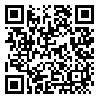Volume 26, Issue 4 (2024)
JAST 2024, 26(4): 805-817 |
Back to browse issues page
Download citation:
BibTeX | RIS | EndNote | Medlars | ProCite | Reference Manager | RefWorks
Send citation to:



BibTeX | RIS | EndNote | Medlars | ProCite | Reference Manager | RefWorks
Send citation to:
Fasahat P, Rezaei J, Sharifi M, Azizi H, Fotuhi K, Mahdikhani P, et al . Analysis of the Genotype by Environment Interactions of Sugar Beet Genotypes under Rhizomania Contamination. JAST 2024; 26 (4) :805-817
URL: http://jast.modares.ac.ir/article-23-68647-en.html
URL: http://jast.modares.ac.ir/article-23-68647-en.html
P. Fasahat *  1, J. Rezaei2
1, J. Rezaei2  , M. Sharifi3
, M. Sharifi3  , H. Azizi4
, H. Azizi4  , K. Fotuhi4
, K. Fotuhi4  , P. Mahdikhani5
, P. Mahdikhani5  , A. Pedram5
, A. Pedram5  , A. Jalilian6
, A. Jalilian6  , B. Babaei7
, B. Babaei7 
 1, J. Rezaei2
1, J. Rezaei2  , M. Sharifi3
, M. Sharifi3  , H. Azizi4
, H. Azizi4  , K. Fotuhi4
, K. Fotuhi4  , P. Mahdikhani5
, P. Mahdikhani5  , A. Pedram5
, A. Pedram5  , A. Jalilian6
, A. Jalilian6  , B. Babaei7
, B. Babaei7 
1- Sugar Beet Seed Institute (SBSI), Agricultural Research, Education and Extension Organization (AREEO), Karaj, Islamic Republic of Iran. , parviz.fasahat@gmail.com
2- Agricultural and Natural Resources Research Center of Khorasan Razavi, Agricultural Research, Education and Extension Organization (AREEO), Islamic Republic of Iran.
3- Agricultural and Natural Resources Research Center of Fars, Agricultural Research, Education and Extension Organization (AREEO), Islamic Republic of Iran.
4- Agricultural and Natural Resources Research Center of West Azerbaijan, Agricultural Research, Education and Extension Organization (AREEO), Islamic Republic of Iran.
5- Agricultural and Natural Resources Research Center of West Azerbaijan, Agricultural Research, Education and Extension Organization (AREEO), Iran
6- Agricultural and Natural Resources Research Center of Kermanshah, Agricultural Research, Education and Extension Organization (AREEO), Islamic Republic of Iran.
7- Sugar Beet Seed Institute (SBSI), Agricultural Research, Education and Extension Organization (AREEO), Karaj, Islamic Republic of Iran.
2- Agricultural and Natural Resources Research Center of Khorasan Razavi, Agricultural Research, Education and Extension Organization (AREEO), Islamic Republic of Iran.
3- Agricultural and Natural Resources Research Center of Fars, Agricultural Research, Education and Extension Organization (AREEO), Islamic Republic of Iran.
4- Agricultural and Natural Resources Research Center of West Azerbaijan, Agricultural Research, Education and Extension Organization (AREEO), Islamic Republic of Iran.
5- Agricultural and Natural Resources Research Center of West Azerbaijan, Agricultural Research, Education and Extension Organization (AREEO), Iran
6- Agricultural and Natural Resources Research Center of Kermanshah, Agricultural Research, Education and Extension Organization (AREEO), Islamic Republic of Iran.
7- Sugar Beet Seed Institute (SBSI), Agricultural Research, Education and Extension Organization (AREEO), Karaj, Islamic Republic of Iran.
Abstract: (1329 Views)
The sugar beet crop has always been attacked by various pests and diseases. Rhizomania viral disease, which has spread in different regions of sugar beet cultivation, has become a disease of prime importance for the crop in the last three decades. Resistant cultivar usage is the only reliable way to manage rhizomania disease. In order to identify promising genotypes, eleven sugar beet genotypes with natural infection to rhizomania, in a company with three controls, were assessed in a Randomized Complete Block Design (RCBD) with four replications. The experiment was conducted in six research stations of Karaj, Khoy, Kermanshah, Mashhad, Miandoab, and Shiraz for two cropping seasons (2020 and 2021). Based on the rhizomania score, all genotypes had acceptable resistance to the disease. The Additive Main Effects and Multiplicative Interaction (AMMI) stability analysis illustrated that the first five principal components were significant and specified 88.8% of the total genotype by environment interaction variance. Gen-7, Gen-10, Gen-11, and Gen-2 were selected as stable genotypes based on the AMMI model. Genotype plus Genotype by Environment Interaction (GGE) biplot results also confirmed the superiority of Gen-10 and Gen-11 regarding sugar yield and stability in disease-infected environments. According to the results of the Multi-Trait Stability Index (MTSI), genotypes Gen-4, Gen-1, Gen-2, and Gen-11 were identified as stable genotypes under rhizomania-infected conditions. By applying different stability measurement methods, in addition to identifying the genotypes’ adaptation to different environments, accurate decisions for future breeding or cultivar registration can be achieved.
Keywords: Genotype selection, Multi-trait stability index, Polymyxa betae, Resistance to rhizomania, Stability parameters.
Article Type: Original Research |
Subject:
Plant Breeding and Genetics
Received: 2023/04/20 | Accepted: 2023/06/25 | Published: 2024/03/31
Received: 2023/04/20 | Accepted: 2023/06/25 | Published: 2024/03/31
Send email to the article author
| Rights and permissions | |
 |
This work is licensed under a Creative Commons Attribution-NonCommercial 4.0 International License. |






